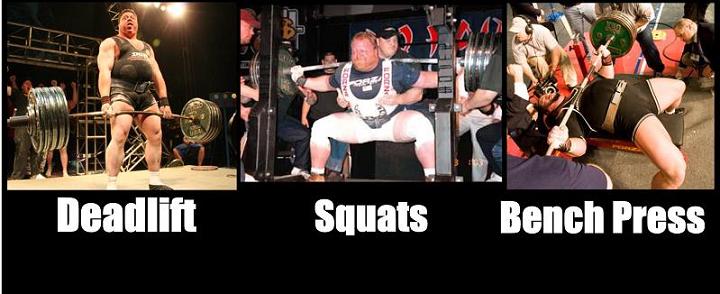|
Let
me start off by saying this article is not going to be about basketball or the Miami Heat. No this “Big Three”
does not need a lot of hype, they are hard gritty blue collar types. This “Big Three” can be found in gyms all
over America. Most of the time, two of the three are often avoided by the casual gym. In heavy lifting circles this group
is legendary. These three are so respected they built a whole sport called powerlifting around them. The article related to
the real big three, the Deadlift, the Squat, and the Bench Press. These three guys here are the true stars when it comes to
strength and power.

The
Bench, Deadlift and Squat are all multi joint, multi muscle, compound exercises. I’m sure anyone reading this is quite
familiar with the term compound exercise. If you’re not familiar with the term, a compound exercise by definition is
an exercise that works several muscle groups at a time. On of the greatest perks about compound exercises is more muscles
get more work and more overall development happens. This in turn builds overall muscle mass and strength a lot quicker. The
Deadlift, Squat and Bench press are not only the poster boys of powerlifting but also the poster boys of compound exercises.
The “Big Three” are known for their abilities to build tremendous
strength and pack on tons of muscle. They are also known as the measure of strength in weightlifting circles. No one ever
asks “How much you leg curl?” People however are always asking “What’s your squat?” or they will ask “How much you bench?” Sometimes these lifts can be just as much as an ego
boost as they are a strength and muscle builder. Whether a person is a powerlifter or simply just enjoys training these lifts,
the goal is usually to have large total numbers on these lifts. No matter how strong you get your numbers though, one thing
can be assured “The chain is only as strong as it’s weakest link!” In sports no matter how good your star
or stars are, they will only be as good as the rest of the team around them. This statement also rings very true when it comes
to the “Big Three” of powerlifting.
The Problem With Only Using The “Big Three” To Improve Your Max
Totals-
When someone first starts powerlifting the ideology is simple. If you want to
get good at squatting, deadlifting, and bench pressing, you squat, deadlift and bench press. I believe this is one of the
best training methods for beginners. It is the best way to familiarize yourself with the exercises and it’s a great
way to get stronger in the exercises quickly. As lifters build a little bit more
of a base with their training, I don’t think this ideology works as well. In the begining people usually make decent
and dramatic strength gains, eventually however those gains will plateau. The time period for this may vary from person to
person. When strength plateaus, two of the best ways to fix this are changing exercises, and techniques. Some “Big Three”
purest will say just keep doing the “Big Three” and that is all you will need, eventually you will break your
plateau. By simply doing the “Big Three” over and over you’re not changing the exercise stimulus enough.
The human body is very adaptive so using the same stimulus over a long period of time will not yield the same dramatic effects
as it did in the beginning of when you started using them.
A second possible problem with relying solely on the squat, deadlift, and bench
press, to increase your max totals is possible muscle imbalances. Remember the squat, deadlift, and bench press are probably
the three best compound exercises you can do. While compound exercises work a lot of muscle groups at once, they do not always
work them evenly. With compound exercises the strongest muscles will do more of the work. When this happens the body learns
to “take the path of least resistance”. This means although you may use good form and technique if there is a weakness in the system the body makes up for this by working stronger muscles more.
For example if your squatting and your glutes are not up to par with other muscles,
a stronger muscle in the group will take over for some of the work the glutes should be doing. By not adding to your exercise
repertoire, not only are you not improving the weak muscles but eventually this could lead to injury.

The Assistant Team-
A great way to improve your “Big Three” is through the help of assistance
exercises. Assistance exercises help develop the movements and muscles used in your main exercise. Assistance exercises are
great for breaking through plateaus because they provide a different type of stimulus to the muscles and help develop weak
or lagging muscles. Another benefit to assistance exercises is they can be used to train parts of your main movements you
may be lagging in. say your trying to go up on your deadlift but you can’t get the initial pull off the floor. An assistance
exercise can help you build strength or speed or both for the bottom part of your deadlift. Assistance exercises are great
because you can hit them really hard for a few weeks and then replace them with another exercise. A good way to use assistance
exercises is to use one for 3-4 weeks and then swap it out of another exercise that helps with area you are working on. By
cycling assistance exercises in and out the body can keep progressing. Once the body recognizes the assistance exercises as
part of the “routine” adaptation and growth will soon halt. By constantly switching exercises the nervous system
is forced to continually adapt and grow. The true key to making assistance exercises beneficial is to find what your weakness
is in the main lift and use the best assistance exercises for your needs.
Assistance Exercises can help your main lifts by:
· Stressing
certain muscles used in the main lift
· Developing
strength or speed in a certain range of the main exercise. Example (working on the bottom, midrange, or lockout of a Deadlift)
· Complementing
the main lift by hitting the same muscle groups from different angles
· Developing
overall speed for more explosion
· Help
build muscle endurance
· Build
size and strength in particular muscle groups
Example of Assistance Exercises – Here are a few assistance
exercises that can be beneficial in upping your “Big Three” totals. This is only a small list of exercises that
can be used as backups for your main lifts.
Deadlift:
· Elevated
Deadlifts-Helps with the bottom part and initial pull off the ground
· Rack
Pulls-Helps build pulling strength, also can be set up at different heights to
help pull thru sticking points
· Stiff
Leg Deadlifts- Helps overall development of the Deadlift
Squats:
· Box
Squats- Helps squatters come out of the hole and improves their explosion
· Bench
Squats- Helps squatters that may get stuck right around parallel
· High
Pin Rack Squats- helps squatters with the top end of their squat and lockout
· Wide
Stance Squats- Helps overall with powerlifter type squatting
|
|
| Laura Phelps-Sweatt box squatting |
Bench Press:
· 5
Second Pause Bench Presses at the bottom- helps with explosion and the bottom part of the Bench Press
· Floor
Presses- Great for overall power and developing mid range strength
· Bench
Press Lockouts- great for the top part of the bench and locking out
· Dumbbell
Presses- Great for muscle development and stability building
|
|
| Ryan Kennelly doing board and chain presses |
The Final Assist-
In the world of Powerlifting and strength, men and women can not live by Squats,
Deadlifts, and Bench Presses alone. While a solid foundation should be built off of the “Big Three”, people should
also use assistance exercises when progress on their main lifts start to stagnate. Assistance
exercises can often help balance muscle discrepancies and lagging muscle groups, help improve areas and techniques that may
be holding lifters back from progressing, and create new stimuli for the body to have to adapt to. If you have built a solid foundation on the “Big Three” but are having trouble progressing on
your max numbers you may want to give some assistance exercises a try.
|

